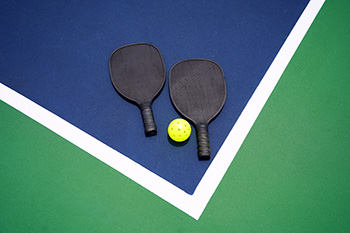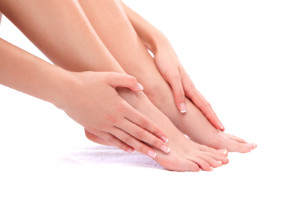Items filtered by date: February 2023
Shoes, Socks, and Foot Pain While Playing Pickleball

Pickleball is a sport that requires the right shoes to be worn and may help to prevent foot pain from developing. Many people choose to wear court shoes, which have smooth soles that can help lateral movement. They are designed with a flared bottom that helps increase stability. Court shoes are generally made with extra padding near the laces, providing additional comfort. These shoes may not be the same size as other shoes you own, so it is beneficial to have your feet measured before making a purchase. People who play pickleball know the importance of wearing the right socks and will often change them because of frequent sweating. It can help to take breaks to rest the feet and may help to avoid foot pain. If you would like additional information about how foot pain can be reduced or prevented while playing pickleball, it is suggested that you consult with a podiatrist.
Foot Pain
Foot pain can be extremely painful and debilitating. If you have a foot pain, consult with Dr. Michael A. Wood from Foot Health Institute. Our doctor will assess your condition and provide you with quality foot and ankle treatment.
Causes
Foot pain is a very broad condition that could be caused by one or more ailments. The most common include:
- Bunions
- Hammertoes
- Plantar Fasciitis
- Bone Spurs
- Corns
- Tarsal Tunnel Syndrome
- Ingrown Toenails
- Arthritis (such as Gout, Rheumatoid, and Osteoarthritis)
- Flat Feet
- Injury (from stress fractures, broken toe, foot, ankle, Achilles tendon ruptures, and sprains)
- And more
Diagnosis
To figure out the cause of foot pain, podiatrists utilize several different methods. This can range from simple visual inspections and sensation tests to X-rays and MRI scans. Prior medical history, family medical history, and any recent physical traumatic events will all be taken into consideration for a proper diagnosis.
Treatment
Treatment depends upon the cause of the foot pain. Whether it is resting, staying off the foot, or having surgery; podiatrists have a number of treatment options available for foot pain.
If you have any questions, please feel free to contact one of our offices located in Lansing, and Chicago, IL . We offer the newest diagnostic and treatment technologies for all your foot care needs.
Why Are My Child’s Feet Peeling?

If a child’s feet are peeling, it is usually from something benign, such as dry skin, athlete’s foot, or another type of skin condition. Skin typically regenerates itself and at the end of the cycle, dead skin sloughs off. This happens naturally when the feet are washed regularly and if this does not happen, the flaking and peeling will be noticeable. Peeling can also result from dehydration, dry air, or a related type of skin damage. For example, if the feet get sunburnt or blisters develop, the skin will eventually peel. Athlete’s foot and eczema can be other reasons for peeling skin, and they can cause inflammation, itching, and scaling. There are other serious reasons for peeling skin, so if your child’s feet are peeling and you are not aware of the cause, it is wise to seek counsel from a podiatrist who can evaluate the condition and provide appropriate treatment.
The health of a child’s feet is vital to their overall well-being. If you have any questions regarding foot health, contact Dr. Michael A. Wood of Foot Health Institute. Our doctor can provide the care you need to keep you pain-free and on your feet.
Tips for Keeping Children's Feet Healthy
- Make sure their shoes fit properly
- Look for any signs of in-toeing or out-toeing
- Check to see if they have Clubfoot (condition that affects your child’s foot and ankle, twisting the heel and toes inward) which is one of the most common nonmajor birth defects.
- Lightly cover your baby’s feet (Tight covers may keep your baby from moving their feet freely, and could prevent normal development)
- Allow your toddler to go shoeless (Shoes can be restricting for a young child’s foot)
- Cut toenails straight across to avoid ingrown toenails
- Keep your child’s foot clean and dry
- Cover cuts and scrapes. Wash any scratches with soap and water and cover them with a bandage until they’ve healed.
If you have any questions, please feel free to contact one of our offices located in Lansing, and Chicago, IL . We offer the newest diagnostic and treatment technologies for all your foot care needs.
Stress Fracture Treatment Begins With Rest

A hairline fracture is another name for a stress fracture. It often happens in the foot and generally affects the second metatarsal bone. The majority of stress fractures occur from overuse, and are a common injury among people who frequently participate in running and jumping activities. Some people can have this type of injury from an accident, or if something heavy drops on the foot. The pain can be worse while walking or standing, and treatment starts by resting and elevating the affected foot. Many patients have an X-ray or other imaging test taken, which is an effective method for determining the severity of the fracture. A cast or a walking boot may be prescribed to stabilize the foot as the healing process occurs. People who have flat feet or an abnormal foot structure may be more prone to developing stress fractures, and it is beneficial to wear shoes that fit properly that can protect the feet. Complete healing takes approximately four weeks, and running can be gradually increased as the foot becomes stronger. If you have incurred a stress fracture, please consult a podiatrist who can offer you treatment options that are best for you.
Activities where too much pressure is put on the feet can cause stress fractures. To learn more, contact Dr. Michael A. Wood from Foot Health Institute. Our doctor can provide the care you need to keep your pain free and on your feet.
Dealing with Stress Fractures of the Foot and Ankle
Stress fractures occur in the foot and ankle when muscles in these areas weaken from too much or too little use. The feet and ankles then lose support when walking or running from the impact of the ground. Since there is no protection, the bones receive the full impact of each step. Stress on the feet can cause cracks to form in the bones, thus creating stress fractures.
What Are Stress Fractures?
Stress fractures occur frequently in individuals whose daily activities cause great impact on the feet and ankles. Stress factors are most common among:
- Runners
- People affected with Osteoporosis
- Tennis or basketball players
- Gymnasts
- High impact workouts
Symptoms
Pain from the fractures occur in the area of the fractures and can be constant or intermittent. It will often cause sharp or dull pain with swelling and tenderness. Engaging in any kind of activity which involves high impact will aggravate pain.
If you have any questions please feel free to contact one of our offices located in Lansing, and Chicago, IL . We offer the newest diagnostic and treatment technologies for all your foot and ankle needs.
What Is in a Wound Kit?

Some individuals, such as people who are diabetic, may be particularly susceptible to developing wounds on their feet. Therefore, these individuals may benefit from always having some kind of professional wound kit handy in case they must treat wounds on the feet. Many patients might wonder what exactly is in a wound kit like this. Although it can vary from person to person, a standard wound care kit will contain certain essential items. These can include items such as gauze pads of different sizes and rolled gauze. Additionally, a wound care kit may have non-stick pads and paper tape. If you are looking into buying a wound care kit for your own feet, contact a podiatrist today for more advice on foot wound care.
Wound care is an important part in dealing with diabetes. If you have diabetes and a foot wound or would like more information about wound care for diabetics, consult with Dr. Michael A. Wood from Foot Health Institute. Our doctor will assess your condition and provide you with quality foot and ankle treatment.
What Is Wound Care?
Wound care is the practice of taking proper care of a wound. This can range from the smallest to the largest of wounds. While everyone can benefit from proper wound care, it is much more important for diabetics. Diabetics often suffer from poor blood circulation which causes wounds to heal much slower than they would in a non-diabetic.
What Is the Importance of Wound Care?
While it may not seem apparent with small ulcers on the foot, for diabetics, any size ulcer can become infected. Diabetics often also suffer from neuropathy, or nerve loss. This means they might not even feel when they have an ulcer on their foot. If the wound becomes severely infected, amputation may be necessary. Therefore, it is of the upmost importance to properly care for any and all foot wounds.
How to Care for Wounds
The best way to care for foot wounds is to prevent them. For diabetics, this means daily inspections of the feet for any signs of abnormalities or ulcers. It is also recommended to see a podiatrist several times a year for a foot inspection. If you do have an ulcer, run the wound under water to clear dirt from the wound; then apply antibiotic ointment to the wound and cover with a bandage. Bandages should be changed daily and keeping pressure off the wound is smart. It is advised to see a podiatrist, who can keep an eye on it.
If you have any questions, please feel free to contact one of our offices located in Lansing, and Chicago, IL . We offer the newest diagnostic and treatment technologies for all your foot care needs.

